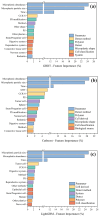Risk Assessment of Microplastics in Humans: Distribution, Exposure, and Toxicological Effects
- PMID: 40574225
- PMCID: PMC12197308
- DOI: 10.3390/polym17121699
Risk Assessment of Microplastics in Humans: Distribution, Exposure, and Toxicological Effects
Abstract
Microplastics are widely present in the environment, and their potential risks to human health have attracted increasing attention. Research on microplastics has exhibited exponential growth since 2014, with a fast-growing focus on human health risks. Keyword co-occurrence networks indicate a research shift from environmental pollution toward human exposure and health effects. Additionally, Trend Factor analysis reveals emerging research topics such as reproductive toxicity, neurotoxicity, and impacts on gut microbiota. This meta-analysis included 125 studies comprising 2977 data samples. The results demonstrated that cytotoxicity in experimental systems was primarily concentrated in Grade I (non-toxic, 62.8%) and Grade II (mildly toxic, 27.6%). Notably, inhibitory effects on cells were significantly enhanced when microplastic concentrations exceeded 40 μg/mL or particle sizes were smaller than 0.02 μm. The Gradient Boosting Decision Tree (GBDT) model was applied to predict cell viability, achieving an R2 value of 0.737 for the test set and a classification accuracy of 81.5%. Furthermore, reproductive- and circulatory-system cells exhibited the highest sensitivity to microplastics, whereas connective-tissue cells had the lowest survival rates. The study also identified an overuse of polystyrene (PS) polymers and spherical particles in experimental designs, deviating from realistic exposure scenarios.
Keywords: cell viability; humans; machine learning; meta-analysis; microplastics; trend factor.
Conflict of interest statement
The authors declare that they have no known competing financial interests or personal relationships that could have appeared to influence the work reported in this paper.
Figures














Similar articles
-
Health professionals' experience of teamwork education in acute hospital settings: a systematic review of qualitative literature.JBI Database System Rev Implement Rep. 2016 Apr;14(4):96-137. doi: 10.11124/JBISRIR-2016-1843. JBI Database System Rev Implement Rep. 2016. PMID: 27532314
-
Signs and symptoms to determine if a patient presenting in primary care or hospital outpatient settings has COVID-19.Cochrane Database Syst Rev. 2022 May 20;5(5):CD013665. doi: 10.1002/14651858.CD013665.pub3. Cochrane Database Syst Rev. 2022. PMID: 35593186 Free PMC article.
-
Cost-effectiveness of using prognostic information to select women with breast cancer for adjuvant systemic therapy.Health Technol Assess. 2006 Sep;10(34):iii-iv, ix-xi, 1-204. doi: 10.3310/hta10340. Health Technol Assess. 2006. PMID: 16959170
-
Impact of residual disease as a prognostic factor for survival in women with advanced epithelial ovarian cancer after primary surgery.Cochrane Database Syst Rev. 2022 Sep 26;9(9):CD015048. doi: 10.1002/14651858.CD015048.pub2. Cochrane Database Syst Rev. 2022. PMID: 36161421 Free PMC article.
-
Individual-level interventions to reduce personal exposure to outdoor air pollution and their effects on people with long-term respiratory conditions.Cochrane Database Syst Rev. 2021 Aug 9;8(8):CD013441. doi: 10.1002/14651858.CD013441.pub2. Cochrane Database Syst Rev. 2021. PMID: 34368949 Free PMC article.
References
-
- Song J., Wang C., Li G. Defining Primary and Secondary Microplastics: A Connotation Analysis. ACS ES&T Water. 2024;4:2330–2332.
Publication types
Grants and funding
LinkOut - more resources
Full Text Sources

